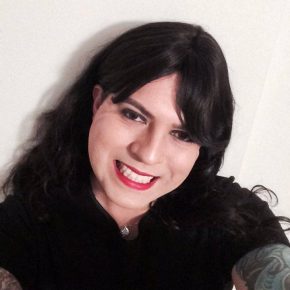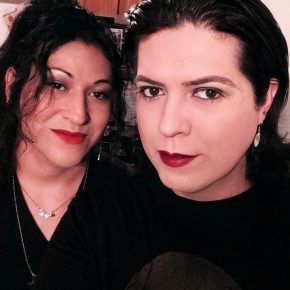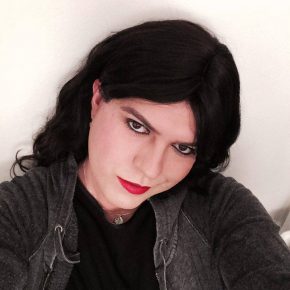
Imagine waking up every day feeling as if your biology had betrayed you by endowing your body with a set of sex organs that did not jive with your gender. Imagine having the primal urge to dress as the opposite sex. Imagine feeling like a girl in a boy’s body. That is exactly the way Samantha and Andrea Matthews felt for nearly 40 years. They are 2 transgender women who are in a committed relationship together.
They are part of a growing number of men and women in this country who are transgender. In fact, 2 studies conducted by groups in Massachusetts and California revealed that about 700,000 of United States adult identify as transgender.
Defined by the Oxford Dictionary, transgender is an adjective “noting or relating to a person whose gender identity does not correspond to that person’s biological sex assigned at birth.” So yes, the oft- heard “woman trapped in a man’s body” is a cliché for a reason.
“I’ve had these feeling since I was pretty young, about 4 years old,” Samantha says. “I used to put on my mom’s clothes and my aunt would put makeup on me. At the time it was just a cutesy thing, not really knowing what it would turn into to, or what it was. No one really knew what it was, I just knew it felt good.”
Andrea said the feeling of being female began early in life for her as well:
“At 10 or 11, I started really discovering who I was and wanting to dress in girl clothes, but it was drilled in my mind: boys are supposed to wear boy’s clothes. So I started hiding and dressing up. I felt complete, but didn’t understand why.”
Pop Culture Tackles the Trans Issue
Beginning around the 1970s, pop culture had taken on the trans issue. Films such as the Al Pacino hit Dog Day Afternoon (1975), Kiss of the Spider Woman (1985), Boys Don’t Cry (1999) and many more movies featured transgender people in either leading roles or as supporting characters.
This century, films like Transamerica (2005), The Skin I Live In (2011) and Dallas Buyers Club (2013) are some representations of flicks that portray the lives of transgender folks. And who can forget the Netflix hit series Orange Is the New Black which touts the African American trans character Sophia, played by Laverne Cox. But let’s face it, before that, the trans issue was not delved into, but merely touched on and mostly within the capacity of comedic relief. Take a look at Some Like It Hot and the MASH show character Clinger, who weren’t truly representing transgender people. They were just coming across as cross-dressing males and something to laugh at.
Struggles of Trans Life
In 2008, the National Center for Transgender Equality and the National Gay and Lesbian Task Force published the results of the largest-ever survey of transgender Americans, which reveals a very startling statistic: 41 percent of transgender people in the study titled “Injustice at Every Turn” said they had attempted suicide. That, compared with 1.6 of the general population, is a sad, and scary number and is due mainly to the lack of acceptance by the trans person’s family and/or society.
Samantha comments:
“There’s so much suicide in the transgender community because those are the people who aren’t loved, aren’t accepted by their families; they’re the ones who’re bullied. When you’re just not fitting in and always wondering what’s wrong with you, those thoughts come into your head.”
Throughout childhood and into adolescence both women, unarmed with any knowledge of what transgender is, both Samantha and Andrea’s thoughts ran the gamut—Am I gay? Am I a cross-dresser? What am I?
Throughout high school, both women were plagued with trying to conform to traditional, society-defined gender roles, even going to the extreme of trying to fulfill a hyper masculine role.
“At that point, I was still trying to live this tough guy role,” Samantha says. “Acting very macho was a shield. I modeled [the masculine persona] on cool guys on television and movies; I tried to be this cool guy everyone would like.”
Andrea echoes the sentiment: “Clint Eastwood was a big male role model for me.”
Coming Out
Samantha reached a breaking point in 2001 and decided to tell a family member about how she felt. She came out to a cousin who she was very close with growing up and he was accepting of the fact: “I felt like if I didn’t come out to somebody, I was going to kill myself.”
Dating was a sticky topic for them both, as neither knew exactly what orientation they were because of the swirling thoughts in their heads, thought which were completely at odds with their biology.
Samantha elaborates:
“I did have relationships with women, but the whole time I was still dressing up in secret so I was always wondering if I was gay. . .I did have an attraction to men, but didn’t want to be labeled gay. It was kind of a mind f**k because I really wanted to fit in, but I had this attraction for men. I didn’t know what to do with that attraction. I was equally attracted to women.”
[Samantha has since discovered she is pansexual, what the Oxford Dictionary defines as: Not limited in sexual choice with regard to biological sex, gender, or gender identity.]
Andrea also experimented with members of both sexes, having her first sexual encounter at 19 with a gay male. Shortly after that, she decided to give the “hetero” male another try and dove head first into a marriage with a woman. She came out to her now-ex wife as a bisexual male, but did not divulge her feelings as a trans woman. She recounts the story:
“I was willing to take the transgender thing to my grave. I tried to live as a married man. I became an automotive mechanic and we tried to build our life together. We were married for almost 12 years.”
The last 2 years of the marriage she describes as “absolute hell.”
Each successive year of Andrea’s marriage was increasingly harder. She found it more and more difficult to maintain a heterosexual relationship and became very unhappy. She was essentially living a double life, all the while trying to adhere to her biological anatomy.
Samantha also gave married life a try. She met her ex-wife in 2002 and began a serious relationship. Her ex already had 2 sons, and she describes being in the relationship in general as another distraction. However, the distraction did not prove to be enough to keep her from her true nature. She explains:
“The band I was in broke up and it was around that time I felt it[feeling as a woman] come back. I had done some laundry and was putting my ex wife’s clothes away and liked the way the material felt. I just thought ‘Oh my god! What am I going to do?’ My whole world blew up again.”
She began dressing up in secret whenever she could. Samantha finally admitted to her ex she was transgender in 2005. The 2 tried to keep the relationship going, and even decided to tie the knot in 2007, hoping that would provide the relationship with the strength it needed to carry on. However, the difficulty proved to be too much, and ultimately the 2 divorced in 2009.
During the course of the relationship, Samantha would vacillate between trying to be the ultimate husband and secretly dressing up as a woman. At one point she sought the help of the church, at which point she was told her feelings were the result of “Satan tricking” her.
“I just needed answers because I turned into this big asshole,” she says. “That’s about the time I sought counseling.”
Fast forward to 2014. Although Samantha had come out to family members, she was still largely presenting to society as a man. But she realized it was time to tell the world who she really was. She decided to attend a transgender support group meeting, where she met a group of transgender women. It was at one of these meeting where she met Andrea.
“It was so inspiring to meet other trans women who were living their lives authentically, as women,” she says.
Those women gave her the nudge to begin hormone therapy. Considering Texas has so many archaic political hoops to jump through regarding hormone therapy for trans people, and the fact that many insurance carriers will not pay for it, Samantha began crossing to Juárez to acquire her hormones, and became one of a countless number of men and women in this area who self-medicate in order to transition.
A short time later, Samantha employed the services of Dr. Hector Granados, a member of the team of Texas Tech doctors who began treating transgender youth in April of last year.
In order to receive hormone therapy, trans people have to receive a referral letter from their primary physician as well as a statement from a therapist stating they are in fact transgender and have been living as their preferred sex for at least a year. Luckily, Samantha had already begun therapy sessions several years prior, and for once her diabetes was somewhat of a blessing because of it necessarily involves the services of an endocrinologist.
Andrea decided to take the plunge and began self-medicating with hormones about 5 months ago. This is only temporary, however, as she has her first appointment with Dr. Granados in May.
Roadblocks
Trans people face many obstacles, which often begin early in life in the form of an identity crisis. Add to that the fact that members of our society can still be extremely hostile towards transgender men and women. But the most abhorrent fact of all is the violence that exists towards these people. Acts of aggression and violence have become so rampant in fact ,that last year members of the House LGBT Equality Caucus established a forum on violence against transgender people.
The president of the Human Rights Campaign (HRC), Chad Griffin, who participated in the forum, made the following statement before the talks:
“Imagine fearing for your life every day. Today, transgender women are more than 4 times as likely to be murdered in the U.S. than other women. We are proud to be a part of this work and hope this form will lead to greater collaboration and action to help end this epidemic of violence.”
Ahead of the forum, the HRC had released a report about anti-transgender violence in which it is stated that there were 53 known transgender victims from 2013-2015. Known is the operative word here because many of the crimes either go unreported, or the acts are not categorized as crimes against transgender people.
The same report found that 90 percent of transgender people had experienced harassment in the workplace.
Although, Samantha and Andrea have been fortunate to not have experienced any violence or harassment personally, each have had their own struggles in coming to terms with who they really are and then coming out to the world.
Andrea is still not 100 percent out however. By day she is an automotive mechanic, and surrounded by what she describes as a “very chauvinistic work environment.”
“It’s a struggle because I love what I do; I love my work,” she says. “But I feel like if I come out at work, I’ll lose my job. I feel like I’m leading a double life.”
Samantha, on the hand, presents herself to the world as a woman 24/7.
For both, being a woman is not a choice or a fetish. It is who they were born to be.
Text By: Denise Nelson Prieto | Photos: Courtesy of Samantha and Andrea Matthews






